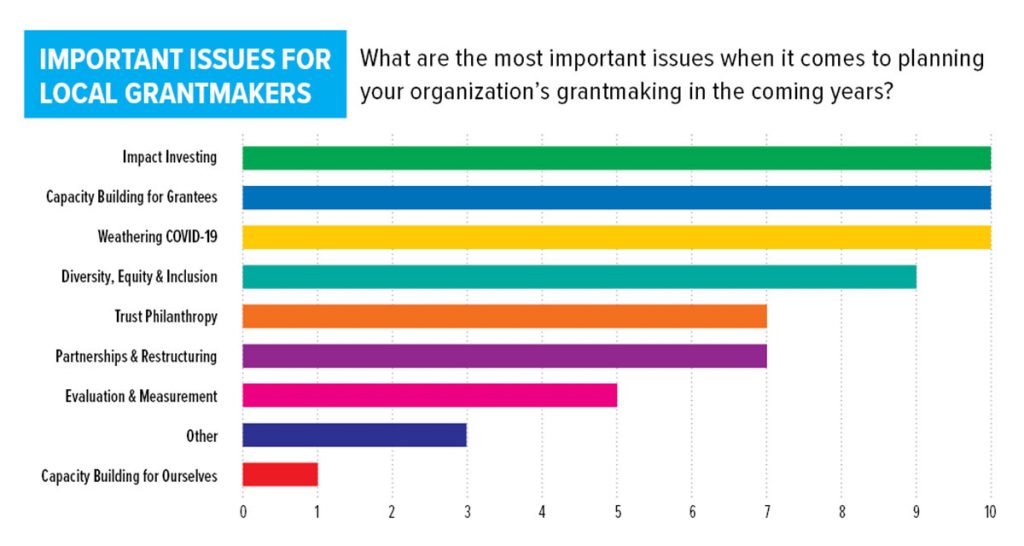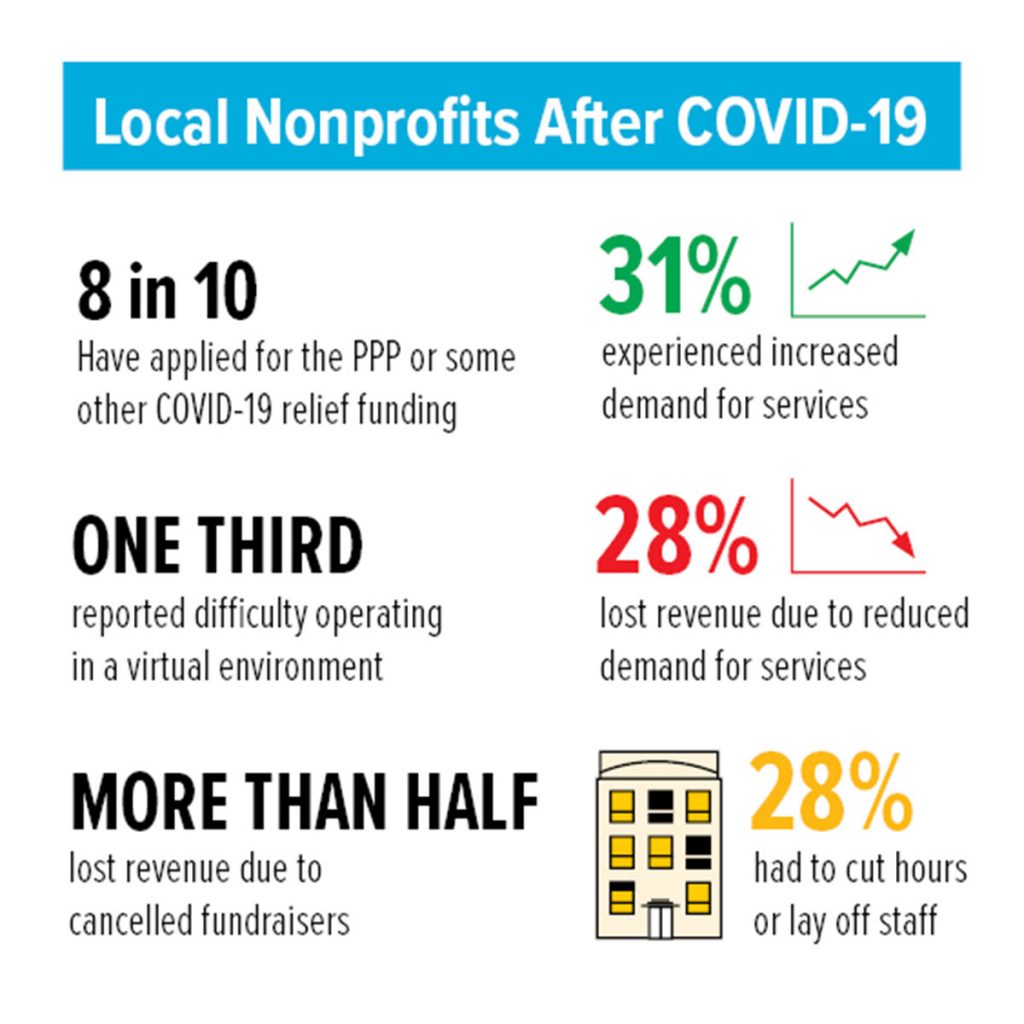Forecast murky for nonprofit sector in unsettled times
Posted on February 2, 2021 By Editor Brooklyn, Downtown, Springfield, Neighborhood News, Riverside, Avondale, Ortega, Murray Hill, San Jose, San Marco, St. Nicholas, Top Stories

Northeast Florida’s nonprofit organizations have found it hard to regain their footing from nearly a year filled with major disruptions caused by COVID-19. The continuing slow roll-out of Coronavirus vaccines, rocky economy, and transfer to a new regime in Washington, have made it difficult for organizations within the sector to “catch their breath” as they endeavor to adapt to “hyper-change,” while serving the community during such unforeseen circumstances.
In a Jan. 14 update of the State of the Sector talk she gave before the Planned Giving Council of Northeast Florida in May, Rena Coughlin, CEO of the Nonprofit Center, discussed the hardships and necessary adaptations nonprofits have faced during the pandemic. She also suggested several ways the sector can reposition itself for strength as it attempts to settle into a new normal.
“We are talking about major disruption and hyper-change, the speed and the pace of which is only equaled to the length and duration of this disruption,” said Coughlin. “When we talked in May, there was still this sense that ‘Wow, we are just catching our breath.’ Organizations report all the time that just when things are settling there is another surge, or regulations change, or the economic outlook changes. There never seems to be any settling for most organizations that gives them time to regroup,” she said.

According to surveys done by the Nonprofit Center of Northeast Florida, the pandemic has forced 28% of local nonprofits to cut their worker’s hours or lay off staff. Yet 31% have experienced an increased demand for services while more than half have lost revenue due to cancelled fundraisers, and 28% have lost revenue due to a reduced demand for services. Eight in 10 nonprofits have found it necessary to apply for PPP grants/loans or some other COVID-19 relief funding. And one third reported difficulty operating in a virtual environment.
What the Nonprofit Center is seeing is a “trifurcation” in the sector, said Coughlin. “One group has had a huge increase on their demand for services with a lack of resources to deliver. Then some organizations have a huge demand for services and have been able to marshal the resources so they can meet capacity. Then there is a third group of organizations that are still struggling to reenter the community and workforce at the level that they had been,” she said referring to civic and cultural organizations that need to convene big groups of people to get their work done. For those organizations, the pandemic has severely impacted earned income and how they deliver on their contracts because it affects the way they are reimbursed or earn revenue.
Many organizations report they are struggling with the conversion to either hybrid or virtual ways of doing business. “It is not just the cancelling of fundraisers that is really hurting organizations, it’s access to unrestricted dollars,” Coughlin said. Many nonprofits were successful in obtaining PPP during the first round, and at least 60% have said they will be applying for PPP grants/loans in the second, even though there will be slightly different requirements. “There is a significant need to shore up the bottom line for nonprofits when it comes to paying for what is usually the most expensive line item in the budget – people, human capital,” she said, adding that those applying for the second round of PPP need to prove they have a 25% reduction in revenue in comparable quarters.
When the Nonprofit Center sent out a recent survey asking how organizations thought they would “come out of 2021,” the response was largely positive. At least 20% were confident they would be fine, while 65% checked the box as “cautiously optimistic.” Only 12% were “uncertain – too many unknowns,” and 3% were “very concerned – unsure if we will be open.” Yet, none checked the box saying they were “gloomy.”
However, in speaking with nonprofit leaders one-on-one, most indicated they are “very exhausted,” said Coughlin. “The words I kept hearing were ‘saturation level.’ They are so worried about their teams, and they are pessimistic about so many things – whether they will raise enough money, whether they will hold their programming – yet when you ask them how they will be at the end of 2021, they will say, ‘We’re going to be all right.’ I don’t know whether it comes with the territory of the nonprofit sector, but I believe there is an optimism bias.”
Repositioning the Sector
Several lessons have been learned as the nonprofit sector struggles to survive the pandemic, the first being that many nonprofits have not closed revealing to the community just how essential they are, she said. A big part of this lesson is a thorough consideration of who, exactly, is an essential worker. Going forward it will be important, perhaps, to redefine just who is essential, and this may differ from the workers who keep the community afloat during a hurricane and those who help distribute food, clean hospitals and buildings, and provide transportation during a pandemic.
The current “dreadful” economy with 10 million unemployed, shows the value of the nonprofit sector as it fills community needs for childcare, healthcare, elder care, and disabled care, she said, adding that nonprofit organizations that supply essential services are necessary in making an economic reignition possible.
“Think about how dependent we are on our institutions of faith, of art and culture, of dance, and theater. These things we have gone without for a very long time. I don’t think that we will feel like we are back to normal until these things are functioning,” she said.
Big reveals
The pandemic has disclosed several inequities – specifically who has access to healthcare, childcare, technology, and the internet – embedded in our economy and institutions, Coughlin said. These inequities were compounded when the social justice movement exploded in the summer of 2020. “So many leaders in the nonprofit community have said to us that this is a top priority,” she said. “One of the few bright spots in this pandemic is this that this disruption exploded a lot of business and cultural norms that had kept organizations from being flexible, creative, and innovative in how we work, how we serve, and how we live.”
Also revealed were gaps in technology, logistics, partnerships, protocols, funding mechanisms, and leadership. “I think what everyone keeps saying is, ‘Let’s not forget this.’ We shouldn’t go back to thinking we fixed it when we haven’t,” she added.
Positives revealed by the pandemic include discovering that virtual work can be effective. Using new technology to break down barriers in service delivery is possible. “We’ve seen huge, positive increases in how organizations deliver, particularly in healthcare, telemedicine, telehealth, and counseling. Even an organization like The Literary Alliance has changed how they work and who they work with. Play therapy for young kids obviously does not translate well on Zoom, but there are other ways we can start thinking of to address things,” she said.
Also, important is to focus on team well-being and fair compensation as well as trust philanthropy, where donors feel comfortable in allowing the nonprofit unrestricted management of their gifts.
Throughout the pandemic it has been apparent the boards of many organizations do not fully understand their organization’s business model, or their role in assisting the executive director when making critical decisions, Coughlin said. “Getting a PPP loan is a perfect example. The boards of some organizations said that they could not apply for loans because they were a nonprofit. They had so little understanding of the essential meaning of a nonprofit. They thought it was illegal for them to have a loan,” she said.
COVID-19 has also showed that operating reserves are critical to the an organization’s survival. “We are hoping that we can, with non-pejorative language, help organizations think about new business models and partnerships on a spectrum from cooperative partnerships to mergers,” she said.
Important issues for local grantmakers
Coughlin said she was recently in a meeting where she had an “out of body” experience. “I was the only nonprofit representative on the call and there were a lot of people with a lot of wealth talking about how great a year it was,” she remembered. “How do you reconcile what truly was for so many investors a very good year with the reality of the situation for the majority of the rest of the universe?”
Local philanthropists have continued to make major contributions during the pandemic, but at some point, they will be stretched thin, she said. Meanwhile, a fair portion of everyday donors has diminished. “We lost some 30,000 people who contributed small, itemized deductions to the recession. It is a big question as to what the impact will be after this pandemic is over.”
In a recent Nonprofit Center survey, philanthropists noted the top issues they consider when giving. At the top of the list were impact investing, capacity building for grantees, and weathering COVID-19. Slightly below was bringing diversity, equity, and inclusion to the organization. Trust philanthropy, and partnerships and restructuring also got high marks.
As the pandemic drags on in 2021, Coughlin had three points of advice to share with nonprofit leadership: 1) Stay hyper-relevant; 2) Be willing to develop and pivot operations; 3) Capitalize on new initiatives and partnerships.
“Stay hyper-relevant. You have to communicate and advocate and make sure people know you are still here, and you are still working – that you are still delivering on your mission,” she said, adding it is important organizations expand hybrid, synchronous service, learning, to examine infrastructure needs and to prep for the future minimum wage when it goes to $15 an hour.
Capitalizing on new initiatives and partnerships is also imperative. “Are there opportunities to right-size your organization? Are there merger opportunities for you as a strong organization to initiate or is there a need for you to think about being absorbed into another organization?” she asked.
Investing in diversity, equity, and inclusion to enhance competitiveness in the marketplace is also important, which dovetails with prioritizing staff care and staff development. In a 2019 survey, the Nonprofit Center asked whether organizations were supporting their executives with at-home technology or internet access. None were. “That has to change,” she said.
By Marcia Hodgson
Resident Community News




 (No Ratings Yet)
(No Ratings Yet)covid-19, Nonprofit Center of Northeast Florida, Planned Giving Council, Rena Coughlin





